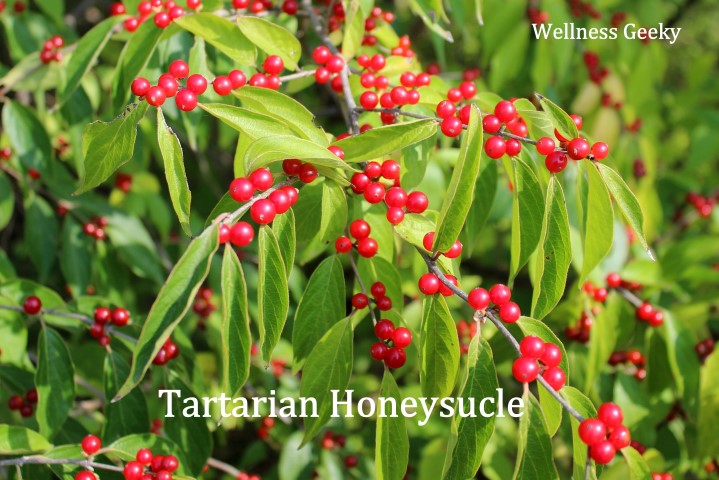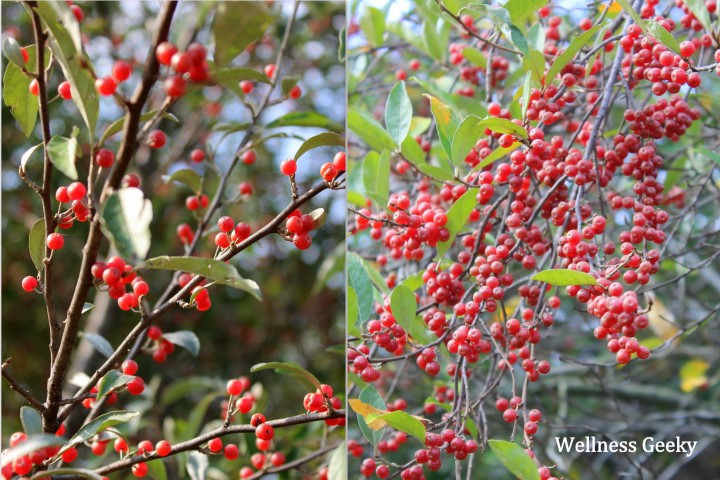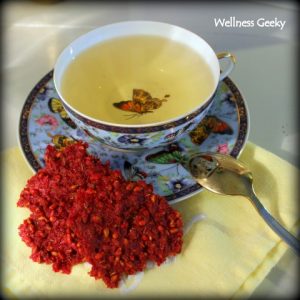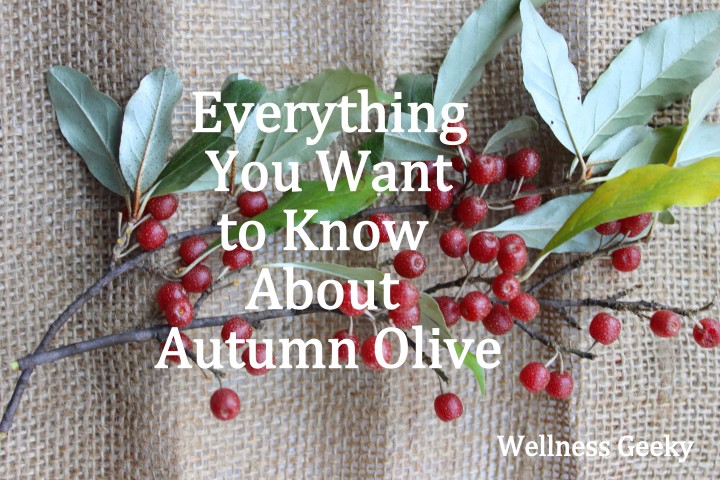
Autumn olive is a little berry with great potential. Its high antioxidants and low sugar content along with abundant bearing in the season when other berries are no more available makes it a valuable addition to a healthy diet.
Bonus: The Easiest Autumn Olive Fruit Leather Recipe
Autumn olive is not the only name this berry is known. You could also hear such common names as autumn berry, Japanese silverberry, autumn Elaeagnus, or spreading oleaster. All these names belong to Elaeagnus umbellata, a plant that came to the US and Canada from Asia and is considered an invasive species are meaning that it’s not the best idea to plant it on purpose, as it has a negative impact on native ecosystems. From another hand why not pick it if it’s already there.
My relationship with autumn olive started 4 years ago. It was in late August when I had a walk with my hubby in the park. I’m that kind of person who likes to munch on whatever edible I can find along my route like mulberries, raspberries, apples, name it. But at that point of a year raspberries and many other berries were over. I was looking at beautiful bushes with silvery foliage and abundant red berries and thinking, what if they are edible?
I tasted one, it wasn’t bitter, and that was a good sign that it could be good to eat. So I took a little twig with leaves and berries home for further identification. At home, I confirmed that it’s indeed edible and called autumn olive.
Since then we eat these little berries every autumn and pick them, so we can make super tasty fruit leather (see the recipe below).
.
Autumn Olive Identification
First of all, check the map below to find out if autumn olive grows in your state. Click on the map or on this link to go to the original EDDMapS website, where the map is interactive, and you can enlarge it and check the plant's presence in the particular county.
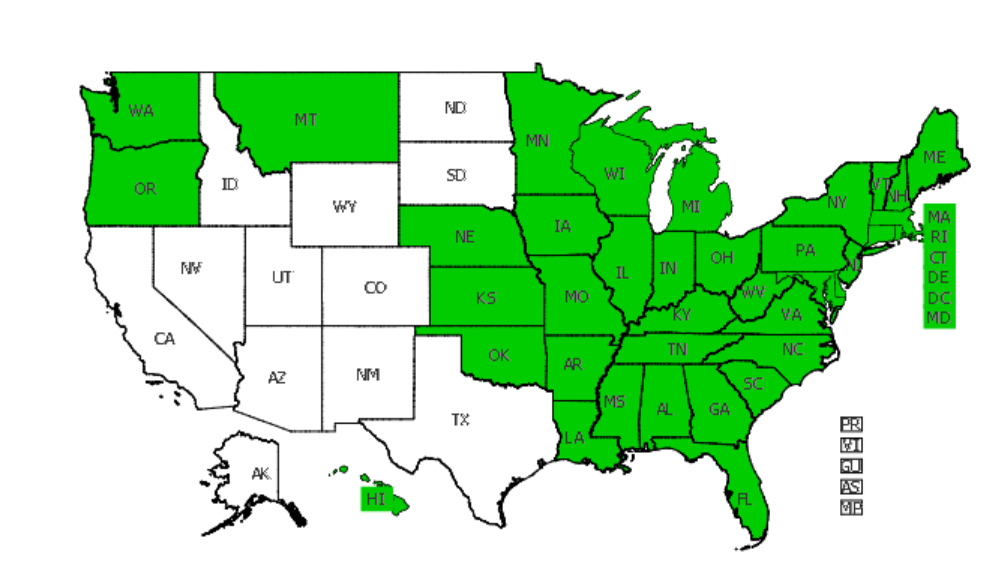
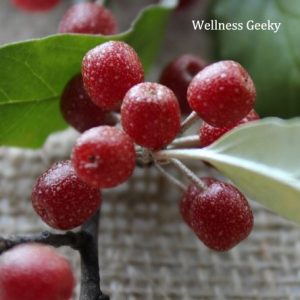
Autumn olive is a deciduous shrub up to 15 ft. high with leaves that are whitish on the backside and have little specks on leaves and berries (see picture on the right).
They taste tart with some sweetness and a little bit of stringiness if not fully ripped. Autumn berry has a small seed that is chewable and feels like grape seed.
The most commonly autumn olive can be mixed with Tartarian honeysuckle (Lonicera tatarica). But the last one has shiny red berries (see picture below) which sit in a cluster of four. Plus, they are bitter. You can try one and spit if it tastes bitter.
If you want to know more about autumn berry history or about other lookalikes, this post is one of my favorites.
.
Health Benefits of Autumn Olive
The most common fact you will read about autumn olive is that it contains 5 to 15 times more antioxidant lycopene than tomatoes. But besides lycopene autumn berries is also a source of vitamin C (around 28mg/100g), as well as other vitamins, antioxidants, and minerals.
Traditionally in Asia autumn olives are used to treat and prevent myocardial and pulmonary infections as well as various forms of cancer. Many US studies also have shown the anticancer potential of autumn olive.
How And When to Pick
The berry starts to ripen in August and could be found even in late November, though the max harvest is from mid-September to mid-October.
Berries become red before they fully ripen and taste can vary from plant to plant. Always taste from different bushes and choose the sweetest and the list stringent.
One autumn olive plant can also differ from another in fruit-bearing density (check the picture below). It’s always a good idea to spend more time finding a good plant wholly covered in berries.
Harvesting Method I
The easiest way to collect berries is with a blueberry picker (or comb berry picker). They are not expensive and speed up the process very significantly.
When you harvest with a comb berry picker, you’ll end up having some leaves mixed with berries. To reduce the time separating leaves from berries, choose bushes with fewer leaves. Autumn olives will drop leaves later in autumn. This moment is the best for picking, as berries are fully ripe and the absence of leaves makes harvesting very easy.
Harvesting Method II
If you prefer to pick manually, try to hang a tray on your neck and brush off berries right into the tray with one hand while holding on to the branch with another one.
To make a tray to pick autumn berries merely take the aluminum tray, make holes on each short side and tighten the ends of the rope through each hole. The rope should be long enough so you can hang the tray on your neck, and it would rest around your waist.
You can also use a large but shallow plastic container, cardboard box, or fruit tray, as well as a serving tray with handles, to make a tray for autumn olive picking.
.
Autumn Olive Recipes
Now the most exciting part… What can you do with your harvest of autumn berries?
And the easiest way will be to make fruit leather. I make two different kinds of fruit leather, depending on how much time I have. You can find the easiest recipe below.
Is Autumn Olive Bad?
We called for our own lab tests and found that the oil was measured correctly and that the majority of the 4,000 items in her test were within the margin of error. However, because different companies measure oil differently, we can't tell if the herb oil from Nature's Sunshine is unusually low or if there are other factors at play. Who Should Use It? To get the absolute best effect from any herb oil, consult your doctor first.
And don't go shopping in a late-night infomercial: there are good products with names like Energizing Plus and Prescription: Renewal. We did some research on the ingredient list and read a few reviews of the product, and the long-term results on our skin are promising. However, we found no significant benefit when using a product with actual prescription medicine (as opposed to other products that contain similar ingredients). Nature's Sunshine product also wasn't worth the price tag: our skin tested in "good" territory with other products on the market that cost much less.
Super Easy Autumn Olive Leather
This recipe will make coarse fruit leather with lots of fiber and intact vitamins and enzymes, as berries are raw and uncooked at all.
• Wash your berries and remove any pieces of leaves
• Add sugar, honey, stevia, or maple syrup to taste, or don’t add it at all. If you want the end product to taste like dried cranberry, add a cup of sugar per 2 lb of berries
• Mush the berries with a potato masher or spin them in a food processor
• You can dry fruit leather in a food dehydrator (I have this one, and it’s the best what you can have for your buck) or in the oven.
Drying in a food dehydrator:
- grease fruit roll sheets with oil of your choice (remove excess oil with a paper towel), you can use an oil sprayer if you have one
- spread mashed berries
- dry at 135F for 7-10h or until completely dry
Drying in the oven:
- line cooking tray with parchment paper or non-stick silicone mat
- spread mashed berries
- dry at the lowest oven temperature for 2-4h (mine can’t go lower than 170F)
• When leather is dry and cooled, cut in strips with kitchen scissors or tear apart with hands
• Store in an airtight container or Ziploc in a dry and cold place
N.B. You can add chia, flax, or sesame seeds to the leather as well as cinnamon or other spices.
More Autumn Olive Recipes:
.
Frequently Asked Questions
Can You Eat Autumn Olive Berries Raw?
Absolutely! You can munch on autumn olive berries straight from the bush. They're these cute little round berries, usually red or orange when they're ripe. They've got this sweet-tart thing going on that folks tend to like. But here's the thing: the taste might change depending on where you pick them and when. Just make sure those berries are good and ripe before you take a bite. If they're not ripe, they can be a bit puckering and not so pleasant. These berries are not just tasty; they're also pretty healthy, packing in vitamins and antioxidants. You can get creative and use them in cooking too, like making jams, jellies, sauces, and tossing them into all sorts of dishes.
Are Autumn Olive Silver Berries Edible?
Absolutely! Autumn olive berries are also known as "silver berries" because of those shiny silvery scales on the undersides of their leaves. But don't let the name throw you off; they're still the same delicious berries. You can eat them without any worries. They've got that same sweet-tart thing going on, just like regular autumn olive berries. So, go ahead and enjoy them. Just remember, like their counterparts, these berries taste best when they're fully ripe.
Are Autumn Olive Berries Sweet?
Autumn olive berries can be quite sweet, and that's part of what makes them so delightful. When they're fully ripe, they have this sweet flavor with just a touch of tartness to keep things interesting. But here's the twist: the level of sweetness can vary. It depends on the specific plant and even the year. So, while most people find them sweet, the exact taste might fluctuate. Whether you're plucking them straight from the bush or using them in recipes like jams and sauces, they bring a unique and pleasant sweetness that many folks enjoy, especially when they're good and ripe.
Are Autumn Olive Berries Poisonous?
Autumn Olive berries, scientifically known as Elaeagnus umbellata, are not considered poisonous to humans. In fact, these small, red or golden berries are edible and even celebrated for their nutritional value and health benefits. However, there are certain considerations to bear in mind when consuming them.
Autumn Olive berries are rich in lycopene, a potent antioxidant known for its role in reducing the risk of chronic diseases and potentially protecting against certain types of cancer and heart conditions. Additionally, they contain high levels of vitamins A, C, and E, making them a nutrient-dense fruit.
Despite their nutritional value, it's important to be cautious. The seeds within the berries contain compounds that metabolize into hydrogen cyanide when ingested. Cyanide, in high concentrations, can be toxic. However, the amounts found in the seeds are generally too small to cause harm when consuming the whole berries. Chewing the seeds, however, can release trace amounts of cyanide, which may not pose an immediate threat in small quantities but could potentially accumulate with frequent ingestion.
To enjoy the nutritional benefits of Autumn Olive berries while minimizing risk, it's advisable to consume the flesh of the berry and avoid chewing or crushing the seeds. The flesh is safe and nutritious, offering a tart, slightly sweet taste that can be used in jams, jellies, or even in baked goods.
Moreover, as with any foraged food, it's important to ensure that the berries are gathered from areas free of contamination, such as pesticides or other environmental pollutants. Proper identification of the berries and ensuring they are from a safe, non-contaminated area is crucial.
In conclusion, Autumn Olive berries are not inherently poisonous; their flesh provides valuable nutrients and antioxidants. However, caution should be exercised to avoid consuming the seeds due to their cyanide content. Enjoying the berries in moderation and ensuring they are from a safe, clean environment can make them a flavorful and nutritious addition to one's diet.
